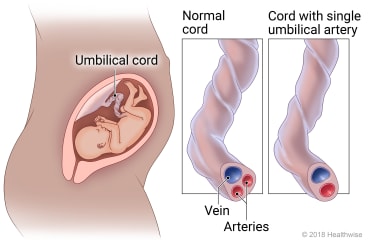What is it?
The umbilical cord connects your baby to your placenta. In most babies, the cord has three blood vessels. There's one vein and two arteries. But sometimes the cord has one vein and just one artery. In that case, it's called a single umbilical artery. It's sometimes called a two-vessel cord. The placenta sends nutrients and oxygen to your baby through the vein. The artery takes waste to the placenta.
Most babies with one artery grow and develop normally. But sometimes whatever caused it can affect the baby's growth. The cord, placenta, or other organs might also have problems.
What causes it?
Doctors aren't sure what causes it. The cord forms early as the baby develops.
How is it diagnosed?
In most cases, a single artery is found with an ultrasound. The test is done in the second trimester. It uses sound waves to make pictures of the baby (fetus) inside the uterus. It helps your doctor or midwife look for problems with the heart, kidneys, or other areas.
If the test shows a single artery, your doctor may do more tests while you are pregnant. For instance, you may have detailed ultrasound tests to see if there are any other problems. A scan may be done in the third trimester to see how your baby is growing.
How is it treated?
There is no treatment for a single umbilical artery. Your doctor or midwife will watch how your baby develops before and after birth. If other problems are found, your doctor or midwife will talk to you about treatment.
Follow-up care is a key part of your treatment and safety. Be sure to make and go to all appointments, and call your doctor if you are having problems. It's also a good idea to know your test results and keep a list of the medicines you take.
Current as of: April 30, 2024


